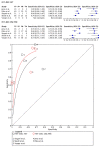Head-To-Head Comparison of PET and Perfusion Weighted MRI Techniques to Distinguish Treatment Related Abnormalities from Tumor Progression in Glioma
- PMID: 37174097
- PMCID: PMC10177124
- DOI: 10.3390/cancers15092631
Head-To-Head Comparison of PET and Perfusion Weighted MRI Techniques to Distinguish Treatment Related Abnormalities from Tumor Progression in Glioma
Abstract
The post-treatment imaging surveillance of gliomas is challenged by distinguishing tumor progression (TP) from treatment-related abnormalities (TRA). Sophisticated imaging techniques, such as perfusion-weighted magnetic resonance imaging (MRI PWI) and positron-emission tomography (PET) with a variety of radiotracers, have been suggested as being more reliable than standard imaging for distinguishing TP from TRA. However, it remains unclear if any technique holds diagnostic superiority. This meta-analysis provides a head-to-head comparison of the diagnostic accuracy of the aforementioned imaging techniques. Systematic literature searches on the use of PWI and PET imaging techniques were carried out in PubMed, Embase, the Cochrane Library, ClinicalTrials.gov and the reference lists of relevant papers. After the extraction of data on imaging technique specifications and diagnostic accuracy, a meta-analysis was carried out. The quality of the included papers was assessed using the QUADAS-2 checklist. Nineteen articles, totaling 697 treated patients with glioma (431 males; mean age ± standard deviation 50.5 ± 5.1 years) were included. The investigated PWI techniques included dynamic susceptibility contrast (DSC), dynamic contrast enhancement (DCE) and arterial spin labeling (ASL). The PET-tracers studied concerned [S-methyl-11C]methionine, 2-deoxy-2-[18F]fluoro-D-glucose ([18F]FDG), O-(2-[18F]fluoroethyl)-L-tyrosine ([18F]FET) and 6-[18F]-fluoro-3,4-dihydroxy-L-phenylalanine ([18F]FDOPA). The meta-analysis of all data showed no diagnostic superior imaging technique. The included literature showed a low risk of bias. As no technique was found to be diagnostically superior, the local level of expertise is hypothesized to be the most important factor for diagnostically accurate results in post-treatment glioma patients regarding the distinction of TRA from TP.
Keywords: MR–perfusion; PET/CT; PET/MR; molecular imaging–cancer; neuro-oncology.
Conflict of interest statement
Smits declares that she received speaker fees from GE Healthcare with regard to the use of perfusion weighted magnetic resonance imaging. The other authors declare that they have had no conflict of interest in the conduction of this research.
Figures





References
-
- Louis D.N., Perry A., Wesseling P., Brat D.J., Cree I.A., Figarella-Branger D., Hawkins C., Ng H.K., Pfister S.M., Reifenberger G., et al. The 2021 WHO Classification of Tumors of the Central Nervous System: A summary. Neuro Oncol. 2021;23:1231–1251. doi: 10.1093/neuonc/noab106. - DOI - PMC - PubMed
-
- Wen P.Y., Macdonald D.R., Reardon D.A., Cloughesy T.F., Sorensen A.G., Galanis E., Degroot J., Wick W., Gilbert M.R., Lassman A.B., et al. Updated response assessment criteria for high-grade gliomas: Response assessment in neuro-oncology working group. J. Clin. Oncol. 2010;28:1963–1972. doi: 10.1200/JCO.2009.26.3541. - DOI - PubMed
-
- Albert N.L., Weller M., Suchorska B., Galldiks N., Soffietti R., Kim M.M., la Fougere C., Pope W., Law I., Arbizu J., et al. Response Assessment in Neuro-Oncology working group and European Association for Neuro-Oncology recommendations for the clinical use of PET imaging in gliomas. Neuro Oncol. 2016;18:1199–1208. doi: 10.1093/neuonc/now058. - DOI - PMC - PubMed
Publication types
Grants and funding
LinkOut - more resources
Full Text Sources
Research Materials

